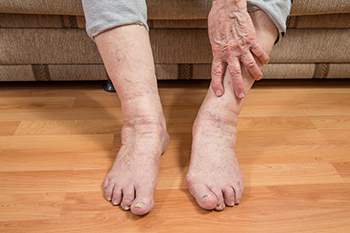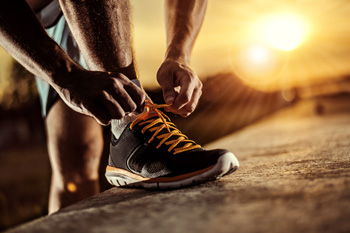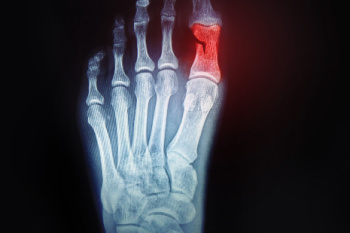Items filtered by date: June 2024
Feet and Aging
 Foot problems are common in older adults, often resulting from the natural aging process, which can lead to changes in foot structure and function. Common issues include arthritis, bunions, hammertoes, and decreased circulation. Additionally, the skin on the feet becomes thinner and has less elasticity, making it more susceptible to injuries and infections. These foot issues can significantly increase the risk of falls, a major concern for older adults. These problems occur due to a combination of factors such as years of wear and tear, decreased physical activity, and underlying health conditions like diabetes or vascular disease. Poor foot care, wearing inappropriate footwear, and reduced mobility can exacerbate these issues. To manage foot problems in older adults, regular foot examinations are essential. Wearing comfortable, supportive shoes, maintaining good foot hygiene, and staying active to promote circulation can help. Moisturizing the feet to prevent dryness and using orthotic inserts for added support is also beneficial. If you are elderly, it is suggested that you include a chiropodist on your healthcare team to ensure comprehensive foot care and advice in addressing any issues promptly and effectively.
Foot problems are common in older adults, often resulting from the natural aging process, which can lead to changes in foot structure and function. Common issues include arthritis, bunions, hammertoes, and decreased circulation. Additionally, the skin on the feet becomes thinner and has less elasticity, making it more susceptible to injuries and infections. These foot issues can significantly increase the risk of falls, a major concern for older adults. These problems occur due to a combination of factors such as years of wear and tear, decreased physical activity, and underlying health conditions like diabetes or vascular disease. Poor foot care, wearing inappropriate footwear, and reduced mobility can exacerbate these issues. To manage foot problems in older adults, regular foot examinations are essential. Wearing comfortable, supportive shoes, maintaining good foot hygiene, and staying active to promote circulation can help. Moisturizing the feet to prevent dryness and using orthotic inserts for added support is also beneficial. If you are elderly, it is suggested that you include a chiropodist on your healthcare team to ensure comprehensive foot care and advice in addressing any issues promptly and effectively.
Foot problems can become increasingly common as we age, making everyday foot care especially important. To learn more about maintaining proper foot health, please consult with Cynthia Chan, B.Sc., D.Ch from Healthy Advantage Foot & Orthotic Clinic. Our practitioner will assess your condition and provide you with quality foot and ankle treatment.
Common Foot Problems
Certain foot problems may be more likely to affect older adults.
Some examples of foot conditions that can be common in older adults include:
Dry, cracked skin
Calluses and corns
Blisters
Ingrown toenails
Deformities such as bunions or hammertoes
Fungal infections
Plantar warts
Systemic conditions, such as diabetes or arthritis, are also more likely to affect older people and manifest symptoms in the feet and ankles.
Daily Foot Care Tips
Having a daily foot care routine can help detect problems early on and prevent future issues.
Things that you can do at home to care for your feet include:
Washing the feet daily with warm water, drying them thoroughly, and then applying a moisturizer
Trimming the toenails straight across and not too short to prevent ingrown toenails
Performing daily foot exercises to improve foot strength and mobility
Wearing shoes when walking to avoid injury
Inspecting the feet daily for any cuts, scrapes, sores, or other abnormalities and seeking prompt treatment if any problems are discovered
If you have any questions, please feel free to contact our office located in . We offer the newest diagnostic and treatment technologies for all your foot care needs.
Tips for Choosing Running Shoes

Choosing the right running shoes is important, whether you are just starting out or training for a race. The perfect pair of running shoes can help prevent injuries and make your runs more enjoyable. Plan ahead based on your running goals and surfaces, including roads, trails, treadmills, or a combination. Begin by walking in your running shoes to get accustomed to how they feel and to gradually build your endurance. Understand your movement patterns by analyzing your pronation. This helps in selecting shoes that offer the right support. Ensure there’s a thumb’s width of space between your toes and the shoe’s tip, and your foot feels secure without any pinching. Once you start running, remember that most running shoes need to be replaced after about 300 to 500 miles to maintain support and comfort. Pay attention to how much cushioning you prefer underfoot, and consider your natural gait and arch type when choosing shoes. Well-fitting shoes should hug your midfoot snugly and provide ample space in the toe box for natural movement. It is also important to match your shoes to the terrain you plan to run on, whether it is a flat pavement or rugged trail. If you experience foot or ankle pain after running, it is suggested that you schedule an appointment with a chiropodist who can analyze your footwear patterns and make appropriate recommendations, including custom orthotics.
The right running shoes can sometimes be difficult to find. With so many options on the market, it’s important to know the unique needs of your feet prior to buying running shoes. If you require assistance, please consult with Cynthia Chan, B.Sc., D.Ch from Healthy Advantage Foot & Orthotic Clinic. Our practitioner can help you maintain the health of your lower limbs and your mobility.
When looking for running shoes, take into consideration:
The type of running you will be doing
The terrain you plan to run on
Your gait or running pattern
Your arch type
Other unique foot needs
A chiropodist can help by examining your feet and your gait to determine what types of shoes may be best for you. Some runners may require motion control shoes, which prevent your foot from rolling too far inward while you run. Others may need stability shoes, which offer more balance, cushioning, and support. When shopping for shoes, make sure that they are the right size, fit comfortably, and are made of breathable materials.
If you have any questions, please feel free to contact our office located in . We offer the newest diagnostic and treatment technologies for all your foot care needs.
Types of Broken Toe Injuries

Broken toe injuries can result from various causes, including direct trauma, stubbing, or heavy objects falling on the foot. These injuries often occur during sports, accidents, or simple everyday activities. There are several types of broken toe injuries, each with distinct characteristics. Simple fractures involve a single break and usually heal without complications. Comminuted fractures, where the bone shatters into multiple pieces, are more complex and may require surgical intervention. Stress fractures, often caused by repetitive impact, present as small cracks in the bone. Displaced fractures occur when bone fragments shift out of alignment, potentially necessitating realignment. Identifying the fracture type is important for appropriate treatment and recovery. If you have broken your toe, it is suggested that you contact a chiropodist who can provide the correct treatment.
A broken toe typically occurs following either a sudden, traumatic injury, like dropping a heavy piece of furniture on the toe. The impact causes the bone to fracture and produces a variety of painful symptoms. If you suspect that you’ve broken your toe, please consult with Cynthia Chan, B.Sc., D.Ch from Healthy Advantage Foot & Orthotic Clinic. Our practitioner can help you maintain the health of your lower limbs and your mobility.
Symptoms
Throbbing pain
Swelling
Bruising
Cracking sound at the time of injury
Difficulty bearing weight on the toe
Difficulty walking
Toe resting at an unnatural angle
Diagnosis
Your chiropodist can diagnose a broken toe through physical examination and imaging studies, such as X-rays.
Treatment
The main goals of treatment are to ensure that the bone heals properly, as a toe fracture that doesn’t heal properly can lead to osteoarthritis. You will typically need to rest the affected toe. You may be prescribed a splint to immobilize the toe while it heals. Icing the affected toe and taking over-the-counter medications can help reduce pain. In cases of severe fractures, surgery may be necessary to reset the broken bones and make sure that they heal correctly.
If you have any questions, please feel free to contact our office located in . We offer the newest diagnostic and treatment technologies for all your foot care needs.